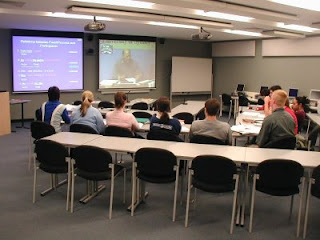 There are some seminaries that are using video conferencing technology over the Internet in which a teacher is located in one centre with a class of students while at the same time students are tuning in from another or from multiple locations.
There are some seminaries that are using video conferencing technology over the Internet in which a teacher is located in one centre with a class of students while at the same time students are tuning in from another or from multiple locations.
For seminaries this appears to be mainly from class to class not class to a student via their computer at home, who might be located in a remote area.
This technology saves the teacher and seminary time in teaching and traveling, it adds more students and gives richness as people pool their insights from different geographical contexts. Video conferencing is live so it offers interaction back and forth between the teacher and students and between the classes in different centres.
Take a Glimpse
Tale a look at what the Dallas Theological Seminary is doing with video conferencing. Judging by the video clip on their site it seems to be a positive experience, at least for the teachers.
The FAQ section explains what it is, why it is offered and it presents some special DTS features. Not all courses are offered at Dallas in this way (presumably because it is deemed to be not as good as the real thing) and during a semester the teacher will appear at least once at each teaching centre to teach in the flesh.
There is a need for the teacher to adjust their teaching style and be attentive to interacting and listening to students via the screens. There is a significant cost outlay, ongoing broadcasting costs and probably a need for technical assistants to be ready at each centre to assist when there are transmission challenges.
This technology depends on the availability of speedy and effective Broadband Internet facilities to ensure that connection is clear and consistent.
Unfortunately, in seminaries and Bible Schools in many parts of the world where they could benefit from this method, they will be restricted by poor or no Internet service and high establishment and running costs.
It would be good to hear from teachers and students who are using this method across the regions and time zones of a country and across international borders. Do write in about your experience of video conferencing for learning and for conferences.
When video conferencing first came on the scene the pundits said it would cut back on business people doing so much travel. But the word is that low quality connections and the favoured, old-fashioned approach of meeting people face to face to negotiate and strike deals has meant that video conferencing has not caught on as the prophets said it would.
But will the soaring oil costs and the corresponding effect on the airline industry mean that video conferencing or an improved incarnation might come into its own? What do you think?
Here is the link to the video conferencing at the Dallas Theological Seminary.
Dr Geoff Pound
Image: Teaching and learning by video conference.
Further:
‘Telepresence’: The next Step from Video Conferencing, TWB, 14 June 2008.
